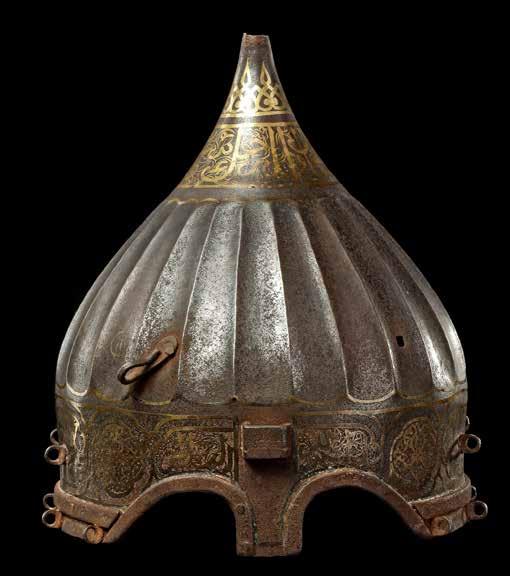
2 minute read
A MONUMENTAL LAJVARDINA POTTERY JUG, ILKHANID PERSIA 13TH
Century
A Persian pottery jug with drop-shaped body and high shoulder rising to a ribbed neck, vertical mouth with small spout and a simple handle. Decorated with gold carved lattice designs interspersed with stylised leaf-motifs on a cobalt-blue ground, beneath a band of angular Kufic inscriptions, shoulder with a band enclosing elegant gilt carved perched bird, a cow and mythical beasts under a band of gilt carved interwined chain. The neck similarly decorated with a band of angular Kufic inscriptions.
Inscriptions al-’izz wa al-iqbal wa al-dawam wa al-s’ada / al-s’ada wa al-salam li-sahibihi. ‘Perpetual Glory and increasing Prosperity, constant Elegance and happiness/ happiness and peace for its owner.
Height: 56.5 cm.
Provenance
Ex. collection Soleiman Morad Pour, Geneva. Collected between the two world wars.
Catalogue Note
Lajvardina wares are named after the Persian word lajvard meaning “blue”, characterised by their distinctive lapis blue colour. Originally stemming from the Sanskrit word “rajavarta”, a portion of the King, the word lajvard is Persian for lapis lazuli.
It is applied principally to a group of vessels and tiles covered with a very intense cobalt-blue as is seen here, and then decorated in overglaze enamels, often in red, white and gold. As a term is has also been applied to the turquoise glazed enamel decorated vessels and tiles from the same group, as well as the rare examples worked on a white ground. Tiles in this technique are found in buildings dating from the later thirteenth century, notably from Takht-i Sulayman. It continued in use into the Timurid period in Central Asia, although with different designs. The only dated example is a tile formerly in Richard Ettinghausen’s collection with the date 1315. For a similar decorated tile we refer to Metropolitan museum accession number: 20.120.73.
Estimate € 150.000 - € 200.000
AN INSCRIBED STEEL TURBAN HELMET, ANATOLIA 15TH CENTURY

A fine steel turban helmet, of cylindrical form rising to a swollen band of vertical flutes narrowing to a central pointed apex housing a fixing for a finial, indents for the eyes and nose-guard to front, with applied rings for the nasal guard and plume holders, 17 rings around the lower edge and the rim for the suspension of an aventail, a wide band around base containing cartouches enclosing gilt engraved inscriptions, the helmet is gilded with the mark of the Ottoman arsenal (Kayi tribe), a similar band of gilt inscriptions around the top under a band of interlocked leafy palmettes. Height: 26 cm.
Inscriptions two cartouches above the indents for the eyes contains the Basmallah, with Quran verses “ Allah Akbar, Allah Jalla Jalaluhu’ around the rim
PROVENANCE Private collction, United Kingdom
CATALOGUE NOTE
This helmet, which is characterised by its large yet elegant domical shape with a band of flutes and gently rising finial, is also referred to as a ‘turban helmet’ due to the resemblance of these flutes to the folds on a turban. Turbans could be representative of one’s rank or religious order, and the way that these were wound and the numbers of folds created were particularly important indicators of rank or religious status, some mystical dervish groups would wear turbans folded several times to reflect some important mystical number. The fluted design of the turban helmet might replicate this practice. The religious nature of the turban helmet was underlined by the presence of Arabic inscriptions taken from the Quran. These Quranic inscriptions supposedly provided God’s protective power to the wearer.
Estimate € 40.000 - € 60.000
Lot 66










